The health benefits of roots
Roots are parts of plants that are present inside the soil. There are many root vegetables and all are full of nutrients, and that’s why the health benefits of roots are numerous. Roots can be found above the grounds as well. There are various roots that possess an excessive amount of nutrients. Important roots are Valerian root, Ginger, Licorice root, Moringa root, Suma root, and the list goes on.
Valerian root possesses great benefits i.e. it is helpful in treating sleep disorders as well as depression. It is a perennial herb. It also possesses lots of other benefits such as it is used to treat symptoms of menopause, it is used treating chronic fatigue syndrome, and is also beneficial in controlling seizures. Valerian roots are extensively used in supplements. It is helpful for treating insomnia because it enhances the level of gamma-aminobutyric acid in the brain and these results in soothing effects.
Another popular root that is commonly used in foods, and as an ingredient in nutritional supplements and drugs, is ginger root. It naturally contains many advantages. The most beneficial effect of this root is its healing effect. If it is applied to the wound, it will enhance the healing time. It is also found to be good in use when you are having a cold or flu. It also cures nausea and helps with the proper digestion of food. So anyone can use it who feels motion sickness or nausea while traveling or during pregnancy. Digestion is enhanced as it promotes bile flow. The ginger oil contains an anti-inflammatory effect so it is quite calming in case of arthritis. Ginger is utilized for stones of the kidney since it clears them by breaking them into small pieces. The root of ginger is now commonly used in medicines and in herbs.
Licorice root is one of the most beneficial roots. It helps in treating and alleviating many diseases. These include asthma, canker sores, cold, flu, bursitis, baldness, depression, a fungal disease of the foot, bacterial infections especially Lyme disease, viral infections, ulcers, heartburn, TB, sore throat, gingivitis, etc. it is even beneficial for treating hyperplasia of prostate and menopause symptoms. It is extensively utilized in making herbs because of the presence of pharmaceutical properties. Licorice is even enriched with flavonoids as well as phytoestrogens so you can imagine how beneficial it is. It provides a natural remedy for a number of diseases without producing any adverse effects.
Licorice root, in addition to the above benefits, also contains important properly i.e. it acts as a laxative. It also increases the immunity of our body so we become resistant to a number of fatal infections. It provides a calming effect in case of respiratory system problems while relieving fever and pain symptoms.
The Moringa plant has been known for ages for its nutritional benefits. It has even been used as traditional medicine. It is also useful in treating various disorders and problems related to our bodies. The roots are in particular helpful in controlling circulatory system disorders. They believe to act a role of diuretic drugs and therefore provide diuretic effects. Moringa roots are especially beneficial in treating a number of reproductive tract problems. These are considered good in the treatment of male infertility. These also possess analgesic effects.
Suma root is also commonly used as a medicine. It is active against stress-inducing agents. It is used to treat certain skin diseases, cancers, menopause complaints as well as diabetes. It enhances our adrenal glands and therefore enables normal hormonal release. It also possesses a rich amount of nutrients such as vitamins, fibers, and minerals. It increases your stamina and enables you to be strong physically. It treats your fatigue and makes you active. It also enhances the body’s immunity and is good in treating impotence. It also provides a good anti-inflammatory effect.
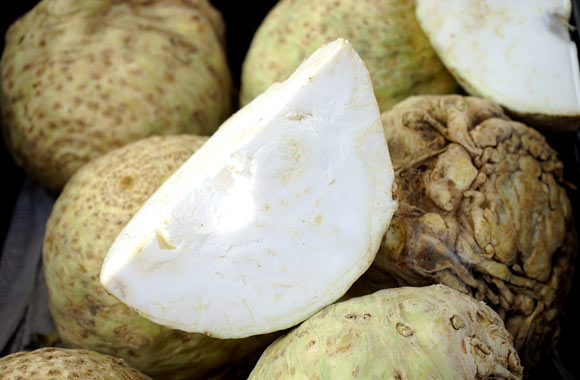
Celery Benefits
Celery is often looked at as a negative calorie food because of the few calories that are found in the vegetable, but there are actually many great health benefits in celery and many reasons you should incorporate it into your daily diet.
Celery is believed to have originated from the Mediterranean basin. Many ancient cultures cultivated the crop because they claimed it had great medicinal purposes due to its oils found mostly in the celery seed. The celery seed was believed to have great healing and preventive powers in colds, the flu, poor digestion, arthritis, liver and spleen ailments, and weight gain due to water retention.
There are two different types of celery varieties, self-blanching or yellow, and Pascal celery or green. In areas of North America, green stalk celery is preferred and is normally consumed in its raw form. In Europe and most other areas of the world, self-blanching celery is preferred. In some areas of the world, celery and celery seed are consumed regularly to prevent and treat high blood pressure.
Despite celery’s high water content and low-calorie amount, the vegetable actually has a great source of vitamins A, B, C, and K, as well as potassium, calcium, and magnesium. Its phytonutrients are believed to help prevent cancer and maintain a healthy heart.
Celery also has the power to preserve brain health. It contains a compound called L-3-N-Butylphthalide, which has been shown in recent studies to help prevent certain brain disorders and illnesses such as Alzheimer’s disease. The L-3-N-Butylphthalide also has the power to treat illnesses such as urinary tract infections. Celery, despite the fact that it is mostly made of water, actually helps your body expel water naturally, without losing any great amounts of potassium.
Trying to conceive? Recent research has shown that celery oil, along with vitamin E, helps to boost a man’s sperm count and mobility. Aldosterone, which is a metabolic product of testosterone, is found in celery and with vitamin E, it can help create an ideal environment for sperm to develop in a healthy manner.
As mentioned earlier, in many areas of the world, celery is used to regulate blood pressure. Celery contains compounds called Phthalides, which help relax the muscles around the arterial walls. Phthalides also help reduce hypertension and stress.
An interesting fact about celery that can help keep your insect bite-free in the summertime is that in recent studies, celery oil has been found to act as a repellent against mosquitoes. Experts say if you apply the oil to your skin, you may see fewer mosquitos swarming around you on hot summer days and nights.
Celery can be consumed in its raw and natural form as well as cooked in dishes or soups. It is an inexpensive vegetable and easy to prepare. With a mild but unique taste, it can actually add a major boost in flavor to your favorite dishes. Celery has also been favored by many people on low-carb diets because of its crunchy texture, low carbohydrate count, low calories, and filling effect. There are so many benefits to this wonderful green stalk; you will not want to miss out!
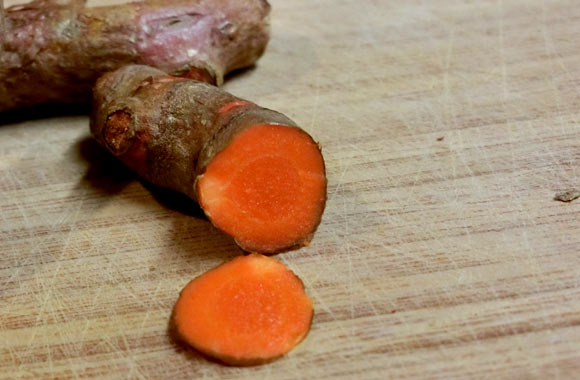
Turmeric Benefits
Turmeric originated in India and other areas of Asia. Throughout history, it has been used in herbal remedies as well as to flavor customary Asian recipes. Many believe that turmeric is one of nature’s most powerful healers, providing prevention and treatment of certain cancers, arthritis, obesity, Alzheimer’s, psoriasis, and more. In fact, many of us actually experience the everyday benefits of turmeric without even realizing it.
Recently, turmeric has been in the media due to certain studies that show it may prevent Alzheimer’s disease. The chemical, curcumin, is continually being tested to see its potential in fighting and preventing dementia-related illnesses. Some say this chemical was praised by the ancient who felt the spice, turmeric, had powers to bring health, luck, and beauty to the consumer.
Ancient Indians also used this spice for its antibacterial and anti-inflammatory benefits. It has been used as a disinfectant to help wounds and cuts heal faster. It has also been used on the skin to help relieve conditions such as eczema and psoriasis.
Today, turmeric is known more for its powerful antioxidant abilities. Researchers feel that the curcumin in turmeric may help fight diseases that are related to cholesterol levels and certain cancers. There have also been studies that have shown turmeric may help block certain types of skin cancer as well as breast cancer.
Turmeric is also commonly used today to relieve inflammation caused by muscle sprains, swelling, and pain from injuries, as well as arthritis. Just as it was used by the ancient Indians, turmeric is used in some modern-day medicine as an antiseptic for cleaning wounds.
Researchers have studied individuals with digestive problems and have found that turmeric has a great deal of value in helping the digestive system as well as the liver. It has been used to help promote healthy digestion, reduce gas and bloating, and even help with irritable bowel syndrome.
Turmeric is also recommended for people who have sinus problems, congestion, and allergies. It acts as an anti-inflammatory to the mucus that can coat the throat, stomach, and digestive tract in individuals with increased inflammation of the sinuses. In addition to individuals with sinus problems, turmeric has been shown to assist people with Crohn’s disease and hemorrhoids.
Turmeric has a distinctive butter but bitter taste. Some say it tastes like a mix of mustard, horseradish, and ginger. Here are some easy and healthy turmeric recipe ideas that are great to add to your daily diet:
- Easy Chicken Korma
- Indian Tomato Chicken
- Spinach, Red Lentil, and Bean Curry
- Barbequed Thai Style Chicken
- Beef and Spinach Curry
- Chutney
- Mustard Pickles
If you are not into cooking in the kitchen but would like to get the health rewards that turmeric offers, you can purchase turmeric supplements online or at your local health store. Experts recommend adults consume 300-800 mg two or three times a day (this would be in the form of curcumin supplements). You can also consume one to three grams of powdered root a day. Regardless of how you consume it, turmeric is a tasty and beneficial spice that we should all incorporate into our daily diets.

Sunchokes Root Benefits
Sunchokes are perennial root vegetables that are easily grown in all areas of the world. They require little fertilizing and can tolerate almost any kind of soil, and some people actually consider them to be a weed because once it is planted, it grows vigorously and is difficult to get rid of. Typically the vegetables are ready for harvest in the fall, but the sunchoke can survive in the ground until spring for an early fresh crop. These are native to North America but are consumed worldwide. They have also been called “The Jerusalem Artichoke”, “Sun Root”, “Earth Apple”, and “Wild Sunflower”. Irregularly shaped and yellow to white to reddish in color, they can be eaten raw as snacks or in salads or they can be cooked inside dishes, casseroles, and soups. This root offers great health benefits to our bodies but unfortunately, not many of us know about the vegetable or even its benefits.
Tubular in shape, the sunchoke looks similar to a small, bumpy potato. It is sweet in taste with a hint of nuttiness, crisp, crunchy, and almost like a combination of an artichoke heart and water chestnut. Its root contains more than three times the amount of iron that is in one equal serving of broccoli. The sunchoke root also contains large amounts of carbohydrate inulin, vitamin B, and vitamin C. Due to the high levels of carbohydrate inulin, the sunchoke makes a wonderful vegetable choice for diabetics because it helps regulate their blood sugar levels. In addition to the vitamins and minerals that sunchokes have to offer, they are very low in calories; four ounces contain only 60 calories!
Here is a brief list of some of the great health benefits that sunchokes root has to offer us:
- Has been used in Europe to treat pancreatitis, kidney stones, hypertension, and gastrointestinal diseases.
- Aids in weight loss and weight control.
- Normalizes our metabolism.
- Great for diabetics because of its amount of inulin.
- The consumer feels full and satisfied after eating sunchokes due to the dietary fiber it contains.
- Relieves constipation.
- Removes toxins from the body.
- Has been tested in Russia as nutritional therapy for patients with diseases associated with immune failure.
- Strengthens the immune system.
- Acts as a tonic for the cardiovascular system.
Sunchokes root can often be cooked in combination with other root vegetables for a wonderful array of flavor and taste. Diced sunchokes, potatoes, and onions cooked in broth and then pureed make a wonderful and nutritious soup; sliced with vinegar, salt, and mustard seeds tastes wonderful after a week of pickling! There has actually been researching that some vegetables, including sunchoke roots, contain a large amount of their nutritious value in the pickling process. If it is raw you can store this for up to one to three weeks.
It might not be the most popular vegetable in the marketplace, but it has some great health benefits. Amazingly, these health benefits can be achieved with minimal effort. Consuming just one to two average size roots per day can do wonders for your overall health!
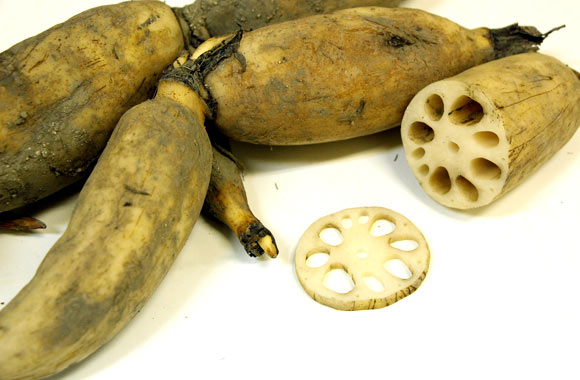
Lotus Root Benefits
Many people picture a beautiful pink or red blossom floating on a lush green pad in water when we hear the term “Lotus”. The Lotus is actually more than just a beautiful floating flower! Lotus root is found in tropical and subtropical Middle East and Asia, from Egypt eastwards to Iran, India, China, Japan, and Australia. It is an aquatic perennial, also known as the Sacred Water Lotus or Chinese Arrowroot. It is cultivated for its seeds, flowers, leaves, and roots, all of which are edible and have great health benefits!
The lotus root is long and shaped like a tube. It can actually grow up to four to six feet in length! Inside the walls of the root are a series of air pockets that once held seeds. The seed pockets allow for the foliage to rest buoyantly on the water while the plant is still alive. The root is very crunchy and starchy in texture and flavor; some people compare it to a water chestnut. The root is very high in dietary fiber and is considered to be a great source of energy. This is because it is very low in fat and protein but very high in carbohydrates.
Lotus root is also known as lily root. It has been used to treat respiratory ailments such as coughing that is related to asthma, colds, bronchitis, tuberculosis, and other lung-related illnesses. Some believe that the lotus root actually cleanses the respiratory system and makes it stronger by melting the mucus down in the body, as well as the lungs.
In addition to acting as a respiratory system aid, the lotus root has been linked to stopping bleeding. Some ancient Chinese healing methods suggest that drinking 2 to 3 glasses of lotus root a day can stop bleeding from the esophagus, stomach, rectum, intestines, nose bleeds, and even gum bleeding. This has not been proven scientifically; however, research has shown that drinking lotus root juice does have some proven health benefits. Individuals with a high fever can drink the juice cold and it is thought to bring down the fever. Drinking lotus root juice has been shown to treat women with anemia due to heavy menstruation, relieve constipation, improve energy and clarity, help with congestion and clear up phlegm.
Lotus root that is baked, broiled, boiled, or steamed can be a great strengthener for the spleen and also promote healthy stomach activity. Lotus root can also be consumed raw. It is often consumed as a snack but works well in salads, soups, stews, and even as a steamed side dish. If you are not into the taste of lotus root, you can also consume it in dried sliced form, lotus root tea, lotus root capsules, and even lotus root extract.
Lotus root may harbor parasites like Fasciolopsis buski, a trematode that is commonly found in aquatic plants like the lotus, water caltrop, Chinese water chestnut, etc. If you consume a lotus root that has not been thoroughly washed and cooked, if infested with the parasite, you could see symptoms that include stomach pain, vomiting, diarrhea, fever, and intestinal obstruction. Seek medical treatment right away if you have any of these symptoms after consuming lotus root. When preparing lotus root at home, just make sure to thoroughly wash and cook the root, cooking it in steam will destroy any parasite larvae.

Parsnip Root Benefits
If you’ve heard of parsnips but cannot picture what they look like, they are similar to carrots but paler and have a much stronger flavor. The parsnip is a biannual plant with a thick root and juicy pulp, which has a unique taste. The plant is usually gray or yellowish in color. Native to Europe and Asia, they are also available worldwide. They are not very high in calories, but they are a great source of potassium and fiber.
Consuming just one cup of parsnips can actually get you just under 7 grams of fiber. This is very beneficial because it promotes healthy digestion, gives you the feeling of fullness, and helps to regulate your cholesterol levels as well as your blood sugar levels.
Parsnip root is also very high in vitamin C and vitamin K. One cup of parsnips contains 25 percent of the daily recommended intake of vitamin C. Vitamin C is crucial to maintaining healthy bones, tendons, blood vessels, and ligaments. Our bodies also use vitamin C to help produce carnitine which helps us metabolize fat. Also in just one cup of parsnips is 25 percent of our daily recommended intake of vitamin K. This is important because vitamin K helps clot our blood and it supports healthy cell growth. This may help reduce the risk of developing osteoporosis later in life.
Parsnips may be extremely helpful for women who are pregnant. In just one cup of parsnips, there is 22 percent of the recommended intake of folate, which is also known as vitamin B-9. Folate helps us manufacture DNA and RNA and can help prevent and treat anemia. Research has shown that consuming parsnips can also help reduce the risk of certain disabling birth defects. Folic acid which is found in parsnips can help reduce heart disease, prevent dementia, and also prevent bone fractures that may be caused by the early onset of osteoporosis.
Parsnip root is also recommended for individuals who suffer from kidney disease, obesity, and cellulite. Consuming parsnips on a regular basis can aid in reducing high blood pressure, relieving constipation, and preventing various heart problems. Parsnips are excellent at improving bowel function and have great health benefits for the liver.
Parsnips can be boiled, roasted, baked, or even consumed raw. If vegetables are not your thing, try taking a parsnip extract which is useful in treating chronic liver and gallbladder diseases. You may also be able to find the dried root or parsnip root oil from a health foods store or vitamin shop.
As with any natural herb, consult your primary care physician before using parsnip root in your daily routine. Although parsnips are beneficial to pregnant women, do not use excessive quantities during pregnancy because their oil may harm the uterus. Consult your doctor or OBGYN if you are pregnant or thinking about getting pregnant and would like to know if it is safe to consume parsnips and parsnip roots before or during pregnancy. Parsnip root also contains oxalates, which can cause health problems for people who have existing kidney or gallbladder conditions. Again, consult your primary care physician before making parsnip root a part of your daily routine.
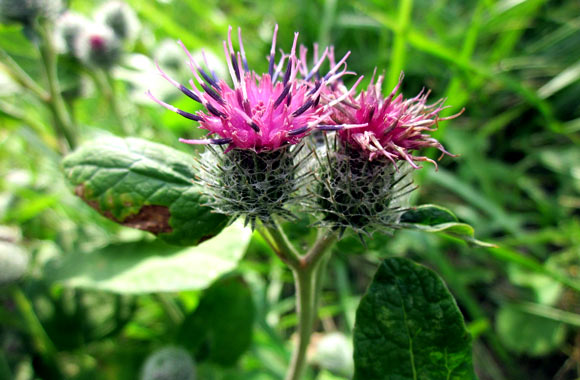
Burdock Root Benefits
Burdock root comes from the burdock plant which is part of the thistle family. Burdock can be found in many areas of the world, but it is native to Asia. Burdock root is a very popular ingredient in many recipes throughout Asia. It is not very popular outside of Asia, however, you will see it in recipes now and then. Some people say that young burdock root tastes similar to artichokes and older burdock can taste very bitter, which most people avoid. Aside from its popularity in Asian cuisine, burdock root has many health benefits that most of us are unaware of.
For many years, burdock root has been used to flush the body and bloodstream of toxins. It has also been used as a diuretic, which increases the amount of urine output and flushes out excess water. One of the most popular uses of burdock root and a natural remedy that has been used for thousands of years is using burdock root to treat infections. Studies have shown that burdock root can be used as an antidote because it neutralizes and eliminates poison in the system. The roots of the burdock contain phytochemicals that help kill certain types of fungi and bacteria, which can be used in treating urinary tract infections, ringworm, acne, and even ulcers.
Speaking of ulcers, burdock root is a wonderful natural health remedy when it comes to our stomachs. Consuming the root has been shown to prevent and also treat gastrointestinal conditions while at the same time stimulating digestive organs. Many believe that burdock root helps control liver damage and prevent future damage.
In addition to treating infections and aiding in our stomach, digestive tracks, liver, and kidneys, burdock root can benefit our skin and our hair as well. When using burdock root in its oil form, it can be very effective in improving overall hair quality, preventing and treating dandruff, as well as preventing hair loss. The burdock oil is filled with the essential fatty acids and phytosterols that help us maintain healthy and young-looking skin and hair. If using burdock oil, it is recommended to be applied during the evening just before you go to bed. The oil will work its magic overnight and then just rinse out in the morning. This is a great routine for people with scalp conditions or who are looking for healthy hair growth.
From a nutrition standpoint, burdock root contains many important vitamins and minerals such as vitamin C, vitamin E, vitamin B complex, phosphorus, potassium, cobalt, zinc, silicon, iron, chromium, thiamine, sodium, and magnesium. These vital nutrients are very helpful in individuals who have diabetes, making burdock root a great supplement for diabetics (consult your primary care physician before incorporating it into your daily diet).
Burdock root can be consumed as a tea to improve digestion, gout, bladder pain, liver conditions, jaundice, hepatitis, and swollen glands. You can purchase burdock tea or make your own by combining herbs such as sarsaparilla root, chicory root, dandelion root, licorice root, burdock root, and yellow dock root.
In addition to tea, burdock root can also be cooked for consumption in recipes, taken as a daily supplement in capsule form, powder form, health juice, and oil. Next time you are at the health food store, check out burdock root either in the produce section or in the herbal supplements aisle. It might just be the right supplement to add to your daily routine!
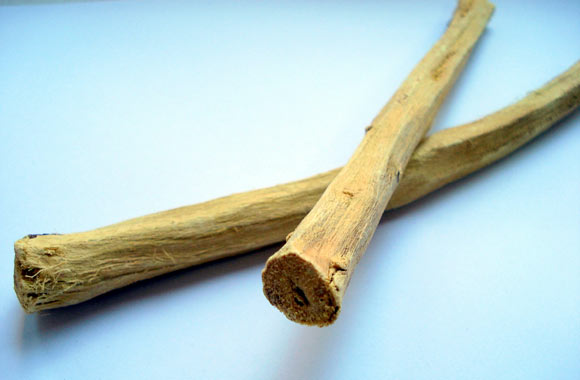
Licorice Root Benefits
Licorice is best known in the United States and Europe as a flavored candy and flavoring for food, recipes, and tobacco. However, for thousands of years, licorice has been one of the herbs in Chinese medicine that has been known to promote longevity in humans. Traditionally used for respiratory and skin issues, it has also been used as a detox aid for your digestive tract and your colon.
As an expectorant, the herb helps loosen phlegm and ease non-productive coughs associated with bronchitis, congestion, allergies, and colds. Licorice root is actually an effective ingredient in many cough medicines and cough drops.
Licorice root has also been used as an anti-inflammatory in treating arthritis, rheumatism, and painful joints. Studies have shown that the herb stimulates the production of cortisone and aldosterone, which seem to be effective anti-inflammatory agents.
In addition to acting as an expectorant and anti-inflammatory, licorice root is a wonderful aid in maintaining good digestion and a healthy digestive tract. The herb soothes the mucous membranes and protects the interior of the stomach and intestinal lining. The mucus that licorice root coats the stomach with may be linked to the prevention of certain diseases such as ulcerative colitis, Crohn’s disease, Celiac disease, and Gastritis. Licorice root is also known to be ancient, for of a mild laxative that is known to cleanse the colon. In addition to the colon, experts believe that licorice root is also great for the bladder and the kidneys.
Licorice root can be taken in a capsule, pills powder, liquid, or tea. You can find licorice root and licorice extract at your local vitamin shop or health foods store. You can also find many products where licorice is an active ingredient and you can still get great health benefits without consuming it. Many skin creams contain licorice because it contains a component called glycyrrhizinate, which makes a great anti-inflammatory, moisturizer and it also contains antioxidants. Some skin creams contain this component and can help in soothing skin pigments or whitening dark spots. If you are looking for a product that contains licorice root, remember that the lower the ingredient is on the ingredients list, the less amount used in the product is far less.
As with any natural herb, there are possible side effects that may occur. You should consult with your primary care physician before adding any natural herb as a supplement to your daily diet and routine. Licorice has been known in some cases to raise blood pressure levels and can also cause water and sodium retention. Individuals who suffer from hypertension should avoid licorice roots. Even though licorice appears to be helpful for ailments like the common cold and allergies, it should be taken in moderation and not in large doses on a regular basis. It has also been shown that certain amounts of potassium can be lost from the body when individuals consume licorice. Licorice root should also be avoided by women who are currently pregnant.
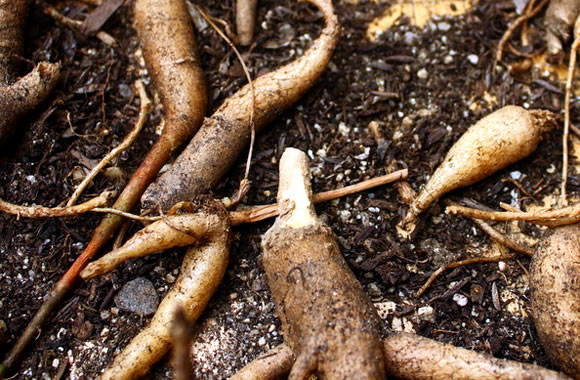
Moringa Root Benefits
The moringa tree originates and is grown in Southeast Asia and Africa as a source of food and natural remedy. For thousands of years, it has been used as a natural remedy for its amazing balance of antioxidants, minerals, and amino acids. Seed pods grow from the flowers of the moringa tree, giving moringa the nickname “drumstick tree.” Some believe that moringa root is a superfood and is found in many recipes today because it has a great source of calcium and potassium.
Early Romans, Greeks, and Egyptians used moringa root for its therapeutic properties and used it to protect their skin, make perfume or scented oils, and purify water for drinking.
Moringa leaf tea is used specifically for women to increase breast milk production while lactating. Moringa leaf is high in vitamin A, vitamin C, iron, and HDL cholesterol levels. The herb has been scientifically proven to have antibacterial benefits. Moringa root bark has been clinically demonstrated to be an effective treatment for post-menopausal ovarian cancer, but should not be used by women of childbearing age.
The leaf of the moringa tree helps boost your energy naturally and is a great source of nutrition. The amount of energy you receive after consuming the leaf of the moringa tree is not the result of sugar, so it lasts for a longer period of time. Research has shown that individuals who consume the moringa leaf have noticed a reduction in ulcers, and sometimes even completely healed. Other individuals who suffer from arthritis pain and other inflammations have claimed to have a reduction of pain and swelling after consuming moringa leaf. It has also been proven that the moringa leaf can control blood pressure, treat skin problems such as acne and eczema, and even promote good sleep.
Moringa root also has a positive effect on children. Children who do not eat enough fruits and vegetables, run the risk of not getting enough vitamins. Children who do not get adequate nutrition in their first few years of life are more likely to have problems throughout life. This includes slower language, slower motor skills development, and possibly lower IQ scores. Moringa root can be a great supplement for picky eaters because of the high amounts of vitamins and minerals it contains.
Again, with any natural herb, please consult your primary care physician before adding it to your daily diet. While moringa root offers many wonderful health benefits, it is always best to share your dietary desires and changes with your doctor before implementing them permanently.
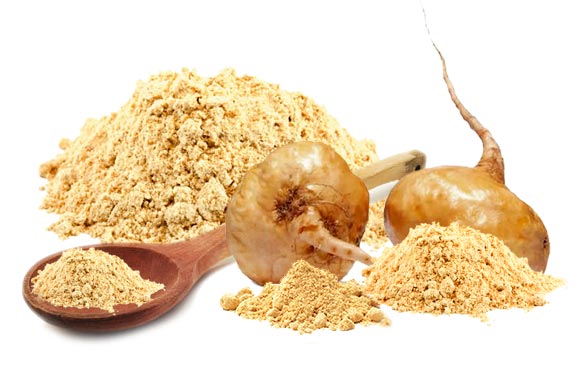
Maca Root Benefits
Maca root is definitely not a commonly used word in today’s household, in fact, most of us probably would not even know what it is if we were asked. However, the Peruvian herb has been used for thousands of years as a remedy and nutritious superfood by the indigenous healers of the Andes Mountains.
In the past 60 years, researchers and doctors are now looking into the properties of maca root and the findings have been quite incredible! The maca root seems to have a unique set of nutrients that directly aid the endocrine system and help the glands to produce fundamental hormones in the correct dosages. Scientific research has shown that the maca root works positively on the hypothalamus (the link between the pituitary gland and the brain), the adrenal glands (which help control heart rate and blood pressure), the thyroid and parathyroid glands (which regulate the metabolism), the pancreas (which helps break down fats, carbohydrates, proteins, and acids), the thymus (part of our immune system), the ovaries (our female reproductive system), the pituitary gland, and testes (in terms of sperm production and libido).
In addition to the endocrine system, reports have shown that maca root affects the body and mind in a variety of other beneficial ways. It is a great source of calcium, phosphorus, vitamin B1, vitamin B2, and fatty acids, which can help calm nerves and work positively on the entire nervous system.
Here is a brief list of what scientists and researchers believe the power of the maca root can do for us:
- Enhance fertility.
- Increase stamina.
- Increases sperm count.
- Improve sexual function and performance in men and women.
- Acts as an aphrodisiac for both men and women.
- Increase energy and endurance.
- Regulate imbalanced hormones.
- Reduce negative symptoms associated with menopause.
- Enhance memory and alertness.
- Reduce symptoms of anxiety and depression.
- Aids in stress treatment.
- Improve healing speeds.
- Prevent and reduce the symptoms of anemia.
- Act as an anti-aging factor to produce youthful-looking skin.
- Improves bone strength.
- Good for healthy teeth.
- Is known for its antibacterial and antioxidant elements
- Used amongst the athletic community as a natural alternative to the use of anabolic steroids for muscle growth.
It is recommended that an individual takes between 500 to 1,000 milligrams three times per day of dried root powder in capsules, to reap the great health benefits of maca root. For increased libido, it is often used in combination with other herbs such as Catuaba, Marapuama, and Yohimbe bark. Maca root can be purchased from your local health food store or vitamin shop.
As with any natural herb or remedy, there are possible side effects. Maca root contains more than 50µg of iodine, which can have a negative effect and possibly worsen an individual’s condition if they suffer from thyroid disease. In some cases, individuals have also experienced allergic reactions such as hives and fatigue. Consult your primary health care physician before consuming maca root or introducing it into your daily diet.

Dandelion Root Benefits
When we think of dandelions, we most likely envision a yellow blossom that matures into a white puffball. We think of when we were children and would pick these little weeds, and blow the white fuzz into the air, not knowing that we were seeding the field with more weeds as the wind carried each little seed. However, this little weed’s roots and tops have been used for medicinal purposes all over the world. So as much as we hate seeing this yellow flower sprout throughout our lawn every year, we may want to rethink our opinion of the dandelion, because it can offer us some really great health benefits.
Chinese herbalists traditionally used the dandelion root to treat digestive disorders, inflammation of the breast in women, milk flow in lactating women, and appendicitis. Native Americans also used the dandelion root to treat skin disorders, swelling, stomach problems, and diseases of the kidneys.
According to the United States Department of Agriculture, dandelions rank in the top 4 green vegetables in overall nutritional value. The nutrients in dandelions are far better than many other green vegetables that we consume on a daily basis. The dandelion root contains great sources of vitamin A, vitamin C, vitamin D, and the B-complex. It also contains minerals like iron, potassium, and zinc. The high iron and zinc in dandelion are great for treating individuals with anemia.
Dandelion root has also been known to assist individuals with diabetes. Studies have shown that the dandelion helps regulate and lower blood sugar levels and cholesterol, making it an excellent aid for balancing blood sugar.
A recent study has shown that consuming dandelion extract can increase urination frequency and act as an herbal diuretic. Dandelion root has been used as a gentle laxative and has also been used to treat liver, kidney, and other digestive problems. Because of its iron content, its diuretic effect can help rid the liver of toxins.
Dandelion root has been found to have significant amounts of antioxidants as well as anti-inflammatory activities. This being said it has been used to treat skin disorders such as acne, eczema, and psoriasis. Its antioxidant properties have also been linked to the treatment of certain types of cancer.
As with any natural herb, there are side effects and one should always consult their primary care physician before adding a natural dietary supplement to their diet. Dandelion root has very few side effects, however, a few allergic reactions have been reported. It is recommended that if you are taking a medication to lower blood pressure or lower blood sugar, you should not consume dandelion root. It is also recommended that pregnant women, or women who are breastfeeding, should not take this herb or should consult their doctors first.
You can purchase dandelion root from any health foods store or vitamin store. It is available in capsules, powder, or liquid extract, and in root juice form. Dandelion root is also available to drink in the form of tea and is very delicious. Best of all, you can actually grow your own dandelions in the convenience of your own home and enjoy the benefits of the root today.
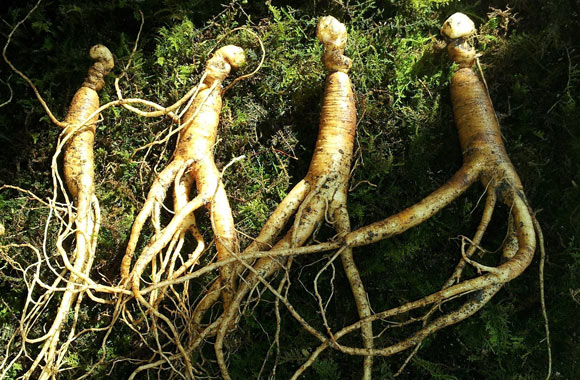
Ginseng Root Benefits
We have all heard in the media that ginseng is a great dietary supplement and offers lots of health benefits. So much that it seems like every item in the health store has “Ginseng Infused” or “With Ginseng” slapped across the label. Ginseng is a great herb, but it is important to know what it can do for us and when and how we should incorporate it into our daily diet.
Ginseng is a perennial plant that grows naturally on the slopes of ravines, typically found in North America, eastern Asia, North China, and eastern Siberia, typically in cooler climates. The Chinese have been using ginseng for over 5000 years as a herb to help heal the body, heart, mind, and soul.
Ginseng helps improve our body’s energy levels and endurance. It increases our alertness and mental clarity while relieving fatigue, stress, and even menstrual symptoms in women. Here are just a few ways that ginseng has been used to help treat health problems and ailments:
- Reduces fatigue
- Reduces stress, anxiety, and depression symptoms
- Increases alertness
- Invigorates the nervous system and immune system
- Improves digestion
- Lowers cholesterol levels
- Prevents certain types of cancer
- Has been used to treat diabetes
- Increase sperm production
- Acts as an aphrodisiac
- Has anti-inflammatory properties that have helped treat chronic pain and arthritis
- Increase endurance
- Fights fever
- Increases motor skills, especially in individuals who have nervous system ailments
Ginseng has also been promoted by the diet industry, claiming that it can increase an individual’s metabolism and reduce their appetite. A variety of ginseng, called Dang Shen, has often been used as an aid in weight loss and is included in many different types of weight loss and diet formulas. It works by increasing the metabolism and improving digestion, helping to turn fat into muscle. Of course, this method most likely works with individuals who regularly exercise and consume a well-balanced diet. Research has shown that while ginseng increases one’s energy levels and acts as a body strengthener, it also reduces one’s appetite. Individuals who have vigorous workout routines must be careful when consuming ginseng because of its appetite-suppressing qualities. If not taken correctly and the proper diet is not maintained, this could result in fatigue, prolapsed organs, and chronic diarrhea.
As a fundamental herb in customary Chinese medicine, ginseng is one of the most useful and widespread forms of herbal remedies we use all around the world today. With many different types of ginseng to choose from, such as Dang Shen, Siberian Ginseng, and Tienchi, ginseng offers a remedy to many ailments our body experiences and also helps prevent such ailments and illnesses. With very few side effects, it can be included in meals, consumed as a tea, or taken in supplement form, it is always best to consult your primary care physician before adding a natural herb as a dietary supplement to your daily diet. With so many health benefits options, ginseng may be one of the most effective and easy-to-use ways to treat common symptoms and ailments.
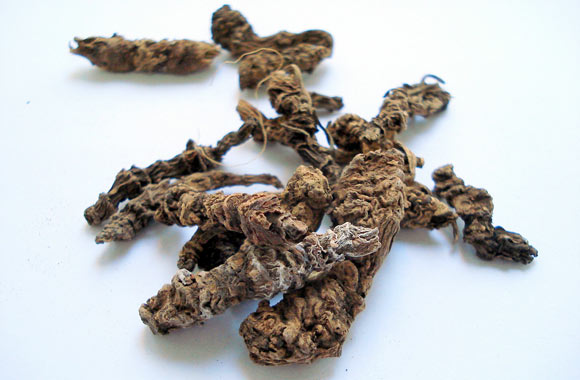
Valerian Root Benefits
Do not feel bad if you have never heard of valerian root. Most people are not aware of what it is and what it is used for. The truth is that this herb can offer health benefits from treating insomnia to curing depression. It is definitely a herb that you should know about and possibly incorporate into your diet.
Valerian root is a herb that comes from the perennial plant Valerian Officinalis, which is typically found growing in North America, Europe, and Asia. It is typically sold in a powdered form or as fresh juice. It has been used for centuries as a medicinal herb. The herb became very popular in the 16th and 17th centuries to treat symptoms such as nervousness, headaches, and unsteadiness.
Primarily used as a sleep aid, valerian root is great for people who suffer from insomnia. It is very mild and natural, so it does not work like the over-the-counter drugs that will “knock you out” for the night. Typically, it will take several days or even weeks of consumption before an individual is able to see any results. However, many believe this is a much more natural and healthy way to cure insomnia than taking drugs for immediate effect.
Valerian root tea is a very popular way of consuming the herb. It offers calm and relaxing benefits when consumed and helps deliver the chemical, gamma-aminobutyric acid, to your brain, which alleviates anxiety and restlessness. This is similar to the way that prescription drugs such as Prozac or Valium treat anxiety; however, consuming tea is a much safer way to treat the symptoms.
In addition to its anxiety and stress-relieving qualities, valerian root has also been shown to reduce the symptoms of depression. Individuals who suffer from anxiety are commonly prone to depression. Including valerian roots in their diet can help calm their stress levels, therefore reducing their risk of falling into depression.
Studies have shown that valerian root can help treat certain nerve disorders such as shingles, sciatica, neuralgia, multiple sclerosis, epilepsy, and peripheral neuropathy. In addition to nerve disorders, studies have also shown that valerian root has helped with attention deficit disorder in both adults and children.
With the benefits that valerian root has to offer, there are a few possible side effects that one should be aware of before consuming the herb. As with any natural remedy, not everyone experiences the same results. Some people may have adverse effects from valerian root, such as experiencing nervousness and anxiety rather than relieving tension and feeling relaxed. This herb should not be consumed when driving or operating heavy machinery or while performing any activity that requires complete alertness. It is not recommended that pregnant women consume the herb or those who suffer from liver disease. It is also not recommended to take this herb with any medication before consulting your doctor. Finally, valerian root should not be mixed with alcohol, due to its sedative qualities.
Valerian root may be an amazing treatment for you if you suffer from insomnia or have anxiety issues. Talk to your primary care physician about the benefits of valerian root to see if it may be the right treatment for you.

Ginger Root Benefits
We have all seen ginger or ginger root as an ingredient in a recipe or as a garnish next to sushi, but what is it really and what makes it so great other than it has a unique and distinctive taste? The truth is that this herb not only adds flavor and zest to our food but it also is known to help remedy many illnesses and prevent many diseases.
Ginger root, also known as just Ginger, is a herb also known as a spice because of its strong and distinctive flavor. Originating from India and also China, ginger is used in many Asian foods, and now it is also used to sweeten foods in Western cooking, such as in recipes like gingerbread and ginger ale. However, aside from its sweetness, it is also a medicinal ingredient that has been used to treat headaches, colds, nausea, and even cure diabetes.
This powerful herb has been used as a natural remedy to treat different illnesses and disorders for centuries. Many believe that ginger has great cancer-fighting elements. Studies have shown that ginger has induced cell death in ovarian cancer cells and can possibly reduce or slow the growth of colorectal cancer cells.
Ginger is well known as a remedy for travel sickness, nausea, and indigestion. Many pregnant women use ginger to aid in morning sickness. Studies have shown that its warming effect after consumption, helps in circulation, lowers high blood pressure, reduces symptoms of bloating, heartburn, flatulence, and even ease menstrual cramps.
Some people are unaware that ginger has antibacterial properties. It can be used as an antiseptic and carminative, and even used to treat food poisoning, intestinal infections, and bacterial dysentery.
In China, people believe that ginger improves and strengthens your heart. Ginger oil is commonly used to help prevent and cure heart disease. Some research has shown that ginger may be helpful in the reduction of cholesterol levels and preventing possible blood clotting, thereby reducing the risk of heart strokes.
Ginger has also been used as a respiratory aid because ginger oil is a proven expectorant. It is effective in treating colds, allergies, asthma, and bronchial symptoms. It also aids in soothing sore throats, especially when added to tea with honey.
Massaging ginger oil or paste on aching muscles can help reduce pain and inflammation. Research has shown that ginger’s anti-inflammatory properties can help reduce the pain associated with muscle aches, arthritis, rheumatisms, headaches, and menstrual cramps.
Some studies have shown that ginger can help aid in certain skin disorders as well. Using the juice of ginger may help prevent and control dandruff on the scalp. We also see ginger in the beauty industry these days, promoting ginger’s antioxidant properties. Research has shown that ginger not only fights skin-damaging free radicals but also improves smoothness and evenness in skin tone. Ginger can be used to lighten age spots and even fight blemishes.
This stimulating and powerful herb has so many great health benefits and it tastes delicious too. There is no reason you should not add this little spice to your daily diet.

Carrot Benefits
“Eh…What’s up Doc?” We’ve all heard this quote by the infamous Bugs Bunny while munching on a carrot. Any doctor in the real world would answer him with, “Good to see you are eating carrots!” Carrots have so many health benefits; it may be difficult to list them all. This delicious, crunchy, and versatile vegetable is one food doctors recommend you always keep in your daily diet.
Carrots are believed to originate thousands of years ago from areas like Afghanistan, Turkey, and Spain. Interestingly, the first cultivated carrots were actually purple and yellow in color. It was not until carrot cultivation spread to Western Europe (in the early 1600s) that its more familiar color of orange and white were more noticeable. The current yellow/orange carrot varieties are now the basis of commercial distribution around the world, mainly through their exclusive taste, usefulness, and nutritional value.
Easy to grow, tasty and high in nutrition, carrots are loved by both children and adults because of their sweet taste and crunchy texture. The vegetable can be grown throughout the year and in almost any season. They are the second most popular type of vegetable, coming in after potatoes. With just under 60 calories per serving, carrots make for a low-calorie and satisfying snack.
Carrots are rich in vitamin B1, vitamin B2, vitamin B6, vitamin K, Fiber, Thiamine, Potassium, and Biotin. Recent studies have shown that consuming carrots regularly can help lower your risk of developing certain types of cancer such as breast cancer, lung cancer, and colon cancer. A compound called Falcarinol in carrots may be responsible for the anti-cancer benefits carrots seem to offer.
Carrots are also known to improve vision. Many of us remember our parents telling us to eat more carrots so that we will have great vision as well as superior night vision. This is actually been proven to be true. High and rich in beta-carotene, which is converted into vitamin A in the liver, is an essential and necessary property for good night vision. In addition, it is believed that the beta-carotene found in carrots may help protect against macular degeneration, which is an illness that is affecting our baby boomer population greatly and is the leading cause of vision loss in Americans 60 years of age and older.
According to research from Harvard University and other studies, carrots contain soluble fiber which can help lower blood cholesterol levels. Also, in this research, experts found that individuals who consumed more than six carrots a day were less likely to suffer from a stroke.
Carrots also have great benefits for our skin! The vitamin A and other nutrients found in carrots can be beneficial in the treatment of acne, dry skin, and evening-out skin tones. As mentioned before, carrots contain high levels of beta-carotene, which acts as an antioxidant and helps fight cell damage to the body, which in turn, helps slow down the aging of cells.
Carrots can be consumed in many forms, raw, cooked, and even juiced. Regardless of how you decide to eat carrots, make sure you incorporate them into your daily diet. The benefits are too great to pass up on this amazing orange vegetable.

Radish Benefits
Looking for a new vegetable snack with crispness, crunchiness, and extreme flavor? Radishes may be the answer for you! Along with their sharp flavor and satisfying crunch, radishes also offer us many cancer-protective and great health benefits.
Believed to have originated in China, the radish was very well appreciated in the Orient, particularly in Japan. The ancient Greeks also held radishes above all other root crops. Radishes made their way over to America with Columbus and the early settlers, and now is a favorite crop amongst many home gardeners.
Radishes are one of the easiest and fastest vegetables to grow, making them wonderful vegetables for first-time gardeners and children to grow. There are two types of radishes, winter, and spring. The spring varieties, also known as “Cherry Bomb”, “Burpee White”, “Crimson Giant” and “Champion”, are to be planted in early spring. The winter radishes are known as “Long Black Spanish” and “China Rose”, and they require a longer growing time than the spring varieties. However, winter radishes store better, have a unique taste, and hold their quality in the garden for longer periods of time.
Radishes can be consumed in their raw form or cooked in meals like stews, soups, side dishes, or casserole bakes. In some areas of the world, pickled radishes are a delicacy and are believed to retain much of their nutritional and medicinal value after pickling.
The first major benefit of radishes is that they are a very low-calorie food and are rich in dietary fiber. Consuming just a ½ cup of radishes has only 2 grams of carbohydrates but will keep you full and give you added energy.
As small of a vegetable as radishes are, they actually are high in vitamins. You can receive up to 14% of your daily vitamin C intake with just a ½ cup of radishes. They also are high in vitamin B6, niacin, vitamin K, folate, and pantothenic acid.
Radishes have sufficient amounts of health-beneficial minerals as well. They have a great supply of potassium, calcium, magnesium, iron, zinc, and manganese.
The vitamin C that you get from consuming radishes acts as a great detoxifier, which can prevent many types of cancer such as kidney, mouth, stomach, and colon cancers. Vitamin C is also responsible for keeping your immune system up to par and helps prevent illnesses like diabetes and heart disease.
Interestingly, radishes also act as an anti-congestive agent. Relieving respiratory congestion and sinus flare-ups due to allergies or infections.
It has also been shown in studies that radishes may help cure jaundice, urinary disorders, fever, insect bites, and kidney disorders. Some experts believe that radishes also may help in fighting and relieving skin irritations and makes a gently antibacterial skin cleanser.
As mentioned before, radishes are a great source of fiber. Some researchers believe that the radish may help in soothing indigestion and actually relieve stress that is put on our digestive tract, healing irritations, and can cause serious problems with our intestines in the long run.
With all these great health benefits of radishes, one cannot pass this delicious, spicy, and crunchy vegetable. Try out your green thumb and plant a few radish seeds in your garden this year. Within as little as 21 days, you can start receiving the benefits of this tiny little red vegetable.

Beetroot Benefits
Beetroot, also known as the garden beet, is a sweet, purple, or maroon-colored root vegetable. Most commonly cultivated in North America, the beetroot can be consumed in a number of ways. Filled with many rich antioxidants and nutrients, many believe that the beetroot may be the next Superfood with all the health benefits it has to offer.
The most popular and well-known health benefit of beetroot is that it is low fat, low calorie, and high fiber food. With only 45 calories per 100 grams, the beetroot also has many vitamins, minerals, and antioxidants.
Eating just three baby-size beetroots a day will equal your recommended five portions of fruits and vegetables per day. The vitamin and mineral-packed vegetables are also known for boosting stamina and helping our muscles work harder.
The beetroot is a great source of Glycine betaine, which is a phytochemical responsible for lowering homocysteine levels in the blood. Homocysteine can promote clotting and plaque formation which can be damaging to our blood vessels and lead to heart disease or stroke.
Beetroots contain folates, which are important for DNA production in our cells. When consumed in raw form, beetroots contain about 109 mcg/100 grams. Cooking beetroots can lower the number of folates we gain, so it is best to eat them in their rawest form.
Vitamin C is also found in beetroots, which helps make this delicious garden vegetable a powerful and natural antioxidant. Vitamin C helps our bodies fight disease and free radicals that are believed to be related to cancer development.
The beetroot also offers us a great source of niacin, pantothenic acid, pyridoxine, and carotenoids. Iron, manganese, and magnesium are also important minerals that are found in beetroots.
Most people do not know that the green leafy part of the beetroot is also very nutritious for our bodies as it contains beta-carotene and other carotenoids. Again, these act as antioxidants and help us stay healthy. Some researchers suggest eating the leaves and stalk boiled or steamed.
Because beetroot is high in folate, iron, and potassium, it is highly recommended by doctors that pregnant women consume vegetables. The roots and leafy greens are excellent for women in general as well as for those who are planning a pregnancy.
Beetroot can be consumed in a variety of ways. The root can be eaten raw in salads, blended, and consumed as a shake or in juice form, steamed, and boiled. Beetroot should be used while they are fresh, but they can be stored in the refrigerator for a few weeks.
In addition to the health benefits that beetroot offers us, there are some interesting and unknown facts about beetroot that might make you think about the garden root more often. Some research has been done stating that the betacyanin found in beetroot can actually help you fight a hangover. Betacyanin helps speed up the detoxification in your liver, which helps your body process the alcohol more effectively. Also, in ancient Roman times, the beetroot was known for its aphrodisiac powers due to the high amounts of boron, which is directly related to our sexual hormone production. Finally, some believe that boiled beetroot can actually cure dandruff. Just boil the root in water and then massage it into the scalp.
So whether you choose to consume beetroot raw, boiled, steamed, or juiced, the health benefits are great from this little red garden root. Offering excellent antioxidant powers, and nutritional benefits, and even when used for personal detoxification, pleasure, or health and beauty, the beetroot is one vegetable you should not ignore.




